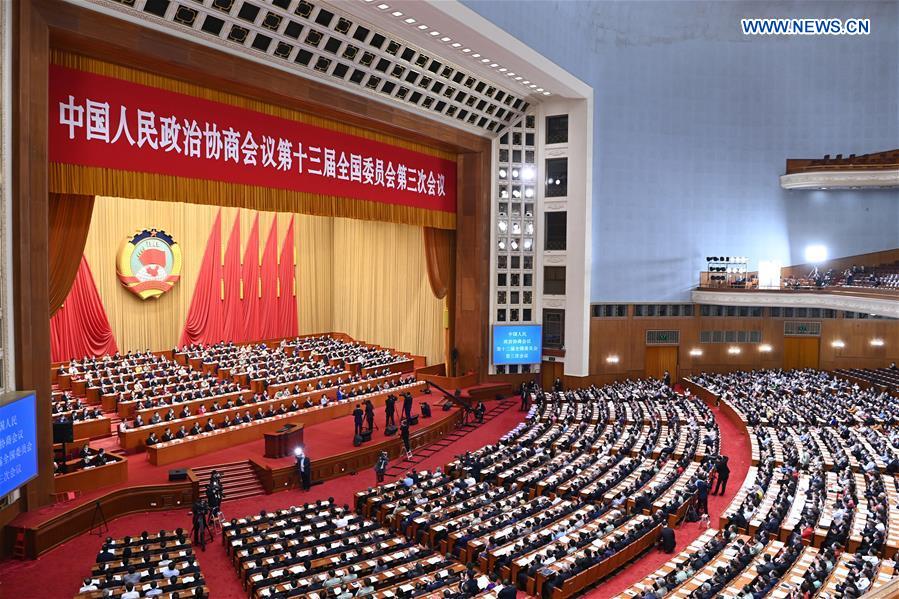
Visitors observe a 5G robot during the 2019 World 5G Convention in Beijing, November 21, 2019. /Xinhua
Visitors observe a 5G robot during the 2019 World 5G Convention in Beijing, November 21, 2019. /Xinhua
Editor's Note: Dr. Zhang Nan is a researcher at the College of Comparative Law, China University of Political Science and Law. The article reflects the author's opinions, and not necessarily the views of CGTN.
Chinese Premier Li Keqiang delivered government work report at the third session of the 13th National People's Congress of the People's Republic of China on May 22, 2020.
Regarding technology and intellectual property protection, Li said: "We will boost our capacity to support technological innovation. We will provide stable support for basic research and application-oriented basic research, and encourage enterprises to increase investment in R&D. We will accelerate the development of national laboratories, restructure the system of key national laboratories, and develop private R&D institutions. We will intensify international cooperation on science and technology. Intellectual property protection will be strengthened. We will introduce an open competition mechanism to select the best candidates to lead key research projects."
The draft civil code also attracts lots of attention during the Two Sessions. It has many articles related to intellectual property rights. In my view, the two most significant ones are Article 123 and Article 1185.
Article 123 designates that civil subjects enjoy intellectual property rights according to law. Intellectual property rights are the exclusive rights enjoyed by the right holders, according to law in respect of the following objects: (1) works; (2) inventions, utility models and designs; (3) trademarks; (4) geographical indications; (5) trade secrets; (6) layout design of integrated circuits; (7) new varieties of plants; (8) other objects prescribed by law.
These articles clearly define what intellectual property is in the Chinese civil law system.
Article 1185 states that in case of intentional infringement of intellectual property rights, if the circumstances are serious, the right holders shall have the right to claim corresponding punitive damages.
This article creates sharp "teeth" against the infringers and demonstrates China's resolution to crack down on infringements.

The second plenary meeting of the third session of the 13th National Committee of the Chinese People's Political Consultative Conference (CPPCC) is held at the Great Hall of the People in Beijing, May 24, 2020. /Xinhua
The second plenary meeting of the third session of the 13th National Committee of the Chinese People's Political Consultative Conference (CPPCC) is held at the Great Hall of the People in Beijing, May 24, 2020. /Xinhua
Although this is a tough year for everyone, NPC deputies and CPPCC members at the Two Sessions are bringing forward their proposals to improve intellectual property protection in China.
For instance, the Central Committee of the China Democratic League brought forward a proposal to tackle challenges such as improving the discourse power of enterprises and increasing the punishment of intellectual property infringement.
Several main suggestions are laid out as follows:
The first is building the linkage mechanism of intellectual property protection at different levels and regions. On one hand, the State Administration for Market Regulation can take the lead to establish an intellectual property right protection reporting platform similar to 12315 or 110 within each provincial jurisdiction, and to form a linkage of provincial, municipal and county-level administrative law enforcement departments to safeguard intellectual property rights.
The second is strengthening the enforcement of intellectual property civil cases. The difficulty of enforcement is a major reason why enterprises are not willing to actively use litigation to protect their rights.
Thus, the enforcement departments of the courts at all levels shall give priority to cooperating with enterprises which are intellectual property right holders, including finding clues of the property to be executed, making the decisions of seizure and preservation, and auctioning the assets.
The third is introducing professionals from industry associations to assist enterprises to participate in right protection by means of risk and benefit sharing. Enterprises may be too busy to spend a significant amount of time and energy in protecting their intellectual property rights, so it is crucial to have professionals to assist them.
For this reason, lawyer associations and patent attorney associations can work with enterprises by signing full-risk or half-risk agreements with enterprises, and charging a fee to tackle their IP protection issues.
Furthermore, providing free guidance for patent applications in technological transformation and upgrading are also effective solutions.
All these sparkling points demonstrate China's commitment to and speed in further strengthening intellectual property protection. China is forging ahead with confidence, resolution and action.
(If you want to contribute and have specific expertise, please contact us at opinions@cgtn.com.)